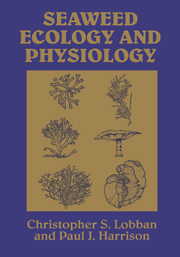Book contents
- Frontmatter
- Contents
- List of contributors
- Preface
- 1 Morphology, life histories, and morphogenesis
- 2 Seaweed communities
- 3 Biotic interactions
- 4 Light and photosynthesis
- 5 Nutrients
- 6 Temperature and salinity
- 7 Water motion
- 8 Pollution
- 9 Seaweed mariculture
- Appendix: Taxonomic classification of algae mentioned in the text
- References
- Index
6 - Temperature and salinity
Published online by Cambridge University Press: 18 December 2009
- Frontmatter
- Contents
- List of contributors
- Preface
- 1 Morphology, life histories, and morphogenesis
- 2 Seaweed communities
- 3 Biotic interactions
- 4 Light and photosynthesis
- 5 Nutrients
- 6 Temperature and salinity
- 7 Water motion
- 8 Pollution
- 9 Seaweed mariculture
- Appendix: Taxonomic classification of algae mentioned in the text
- References
- Index
Summary
Natural ranges of temperature and salinity
Open coastal waters
The surface temperatures of the oceans vary in two primary ways. First, they decrease toward higher latitudes, from about 28°C in the tropics to 0°C toward the poles, although this trend is markedly affected by ocean currents. Because of the California Current, for example, fairly uniform cool temperatures prevail in the seawater along much of the west coast of North America, even though land temperatures change considerably. Second, the seasonal changes in ocean temperatures are larger at midlatitudes. In the tropics and at the poles the annual temperature range is often less than 2°C (Kinne 1970), whereas in midlatitudes 5–10°C is common.
The salinity of open-ocean surface water is generally 34–37 parts per thousand (‰), though lower off the coasts of areas with great rainfall (e.g., the northwest coast of North America), and higher in subtropical areas with high rates of evaporation and low rainfall (Groen 1980). Certain seas have markedly higher or lower salinities: The Mediterranean, because there is a high rate of evaporation and little freshwater influx, has salinities of 38.4–39.0‰; the Baltic, essentially a gigantic estuary, is notably brackish, particularly at the surface, ranging from 10‰ near its mouth to 3‰ or less at the northern extreme. In coastal waters, especially those that are partially cut off from the ocean or are subject to heavy runoff, salinity is characteristically 28–30‰ or lower, even quite far along a coast from the mouth of a major river.
- Type
- Chapter
- Information
- Seaweed Ecology and Physiology , pp. 210 - 240Publisher: Cambridge University PressPrint publication year: 1994
- 1
- Cited by



